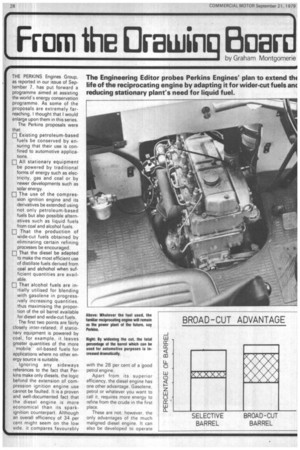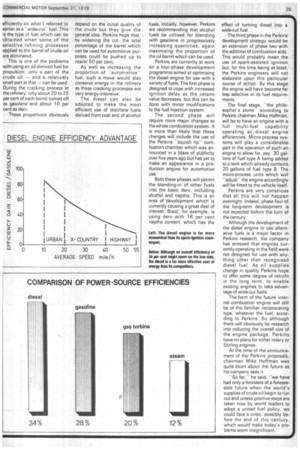( From the rowing Boer
Page 30

Page 31

If you've noticed an error in this article please click here to report it so we can fix it.
by Graham Montgomerie
THE PERKINS Engines Group, as reported in our issue of September 7, has put forward a programme aimed at assisting the world's energy conservation programme. As some of the proposals are extremely farreaching, I thought that I would enlarge upon them in this series.
The Perkins proposals were that: 0 Existing petroleum-based fuels be conserved by ensuring that their use is confined to automotive applications.
0 All stationary equipment be powered by traditional forms of energy such as electricity, gas and coal or by newer developments such as solar energy.
ri The use of the compression ignition engine and its derivatives be extended using not only petroleum-based fuels but also possible alternatives such as liquid fuels from coal and alcohol fuels_ 0 That the production of wide-cut fuels obtained by eliminating certain refining processes be encouraged.
0 That the diesel be adapted to make the most efficient use of distillate fuels derived from coal and alchohol when sufficient quantities are available.
0 That alcohol fuels are initially utilised for blending with gasolene in progressively increasing quantities, thus maximising the proportion of the oil barrel available for diesel and wide-cut fuels.
The first two points are fairly closely inter-related; if statio nary equipment is powered by coal, for example, it leaves greater quantities of the more
"mobile" oil-based fuels for applications where no other energy source is suitable.
ignoring any sideways references to the fact that Per kins make only diesels, the logic
behind the extension of compression ignition engine use
cannot be faulted. It is a proven and well-documented fact that the diesel engine is more economical than its spark
ignition counterpart. Although an overall efficiency of 34 per cent might seem on the low side, it compares -favourably
with the 28 per cent of a good petrol engine.
Apart from its superior efficiency, the diesel engine has one other advantage. Gasolene, petrol or whatever you want to call it, requires more energy to refine from the crude in the first place.
These are not. however, the only advantages of the much maligned diesel engine. It can also be developed to operate efficiently oil what I referred to earlier as a "wide-cutfuel. This is the type of fuel which can be obtained when some of the selective refining processes applied to the barrel of crude oil are eliminated.
This is one of the problems with using an oil-derived fuel for propulsion: only a part of the crude oil -and a relatively small part at that — can be used. During the cracking process at the refinery, only about 20 to 25 per cent of each barrel comes off as gasolene and about 10 per cent as derv.
These proportions obviously depend on the initial quality of the crude but they give the general idea. Perkins hope that, by widening the cut, the total percentage of the barrel which can be used for automotive purposes could be pushed up to nearer 50 per cent.
As well as increasing the proportion of -automotive" fuel, such a move would also conserve energy in the refinery as these cracking processes are very energy-intensive.
The diesel can also be adapted to make the most efficient use of distillate fuels derived from coal and of alcohol fuels. Initially, however, Perkins are recommending that alcohol fuels be utilised for blending with gasolene in progressively increasing quantities, again maximising the proportion of the oil barrel which can be used.
Perkins are currently at work on a four-phase development programme aimed at optimising the diesel engine for use with a variety of fuels. The first phase is designed to cope with increased ignition delay as the cetane value decreases, but this can be done with minor modifications to the fuel injection system.
The second phase will require more major changes to the whole combustion system. It is more than likely that these changes will include the use of the Perkins "squish lip" combustion chamber which was announced in a blaze of publicity over five years ago but has yet to make an appearance in a production engine for automotive use.
Both these phases will permit the blending-in of other fuels into the basic derv, including alcohol and naptha. This is an area of 'development which is currently causing a great deal of interest. Brazil, for example, is using dery with 16 per cent naptha content, which has the effect of turning diesel into a wide-cut fuel.
The third phase in the Perkins development strategy would be an extension of phase two with the addition of combustion aids. This would probably mean the use of spark-assisted ignition but, for the time being at least, the Perkins engineers will not elaborate upon this particular course of action. By this stage the engine will have become far less selective in its fuel requirements.
The final stage, -the philosopher's stone" according to Perkins chairman Mike Hoffman, will be to have an engine with a
full multi-fuel capability operating at diesel engine efficiencies. Micro-process systems will play a considerable part in the operation of such an engine to allow for. say, 30 gallons of fuel type A being added to a tank which already contains 20 gallons of fuel type B. The micro-process units which will "adjust" the engine accordingly will be fitted to the vehicle itself.
Perkins are very conscious that all this will not happen overnight. Indeed, phase four of the long-term development is not expected before the turn of the century.
Although the development of the diesel engine to use alternative fuels is a major factor in Perkins research, the company has stressed that engines currently operating in the field were not designed for use with anything other than recognised diesel fuel. As oil supplies change in quality Perkins hope to offer some degree of retrofit in the long term, to enable existing engines to take advantage of wide-cut fuels.
The form of the future internal combustion engine will still be of the familiar reciprocating type, whatever the fuel, according to Perkins. So although there will obviously be research into reducing the overall size of the engine package, Perkins have no plans for either rotary or Stirling engines.
At the time of the announcement of the Perkins proposals, chairman Mike Hoffman was quite blunt about the future as his company sees it.
-So far,he said, "we have had only a foretaste of a foreseeable future when the world's supplies of crude oil begin to run out and unless positive steps are taken now by world leaders to adopt a united fuel policy, we could face a crisis, possibly before the end of this century, which would make today's problems seem insignificant."'












































































































































